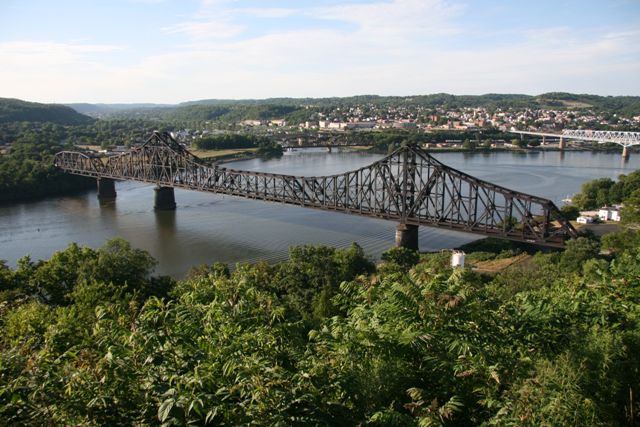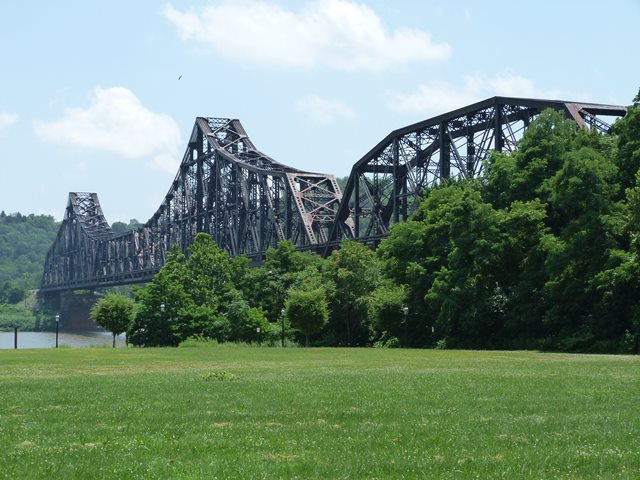We Recommend:
Bach Steel - Experts at historic truss bridge restoration.
Monaca-Beaver Railroad Bridge
Pittsburgh & Lake Erie Railroad Bridge

Primary Photographer(s): Nathan Holth and Rick McOmber
Bridge Documented: July 9, 2009 and July 14, 2011
Monaca and Beaver: Beaver County, Pennsylvania: United States
Metal Cantilever 26 Panel Rivet-Connected Baltimore Through Truss, Fixed and Approach Spans: Metal 12 Panel Pin-Connected Pennsylvania Through Truss, Fixed
1910 By Builder/Contractor: McClintic-Marshall Company of Pittsburgh, Pennsylvania and Engineer/Design: Albert Lucius of New York, New York
Not Available or Not Applicable
769.0 Feet (234.4 Meters)
1,779.0 Feet (542.2 Meters)
29 Feet (8.84 Meters)
3 Main Span(s) and 1 Approach Span(s)
Not Applicable

View Information About HSR Ratings
Bridge Documentation
View Historic American Engineering Record (HAER) Documentation For This Bridge
HAER Data Pages, HTML - HAER Data Pages, PDF
View Historical Article About This Bridge
View Detailed Historical Article From American Society of Civil Engineers
This is one of the largest and most visually impressive bridges in this region which is rich with historic bridges. The main span is a classic cantilever truss style which uses the Baltimore truss design. Constructed in the wake of the collapse of the first Quebec Bridge, the attention this bridge got from the engineering community as well as its traditional yet massive design are all likely no coincidence, especially considering that Albert Lucius, the consulting engineer for the project, actually worked for the Phoenix Bridge Company (which attempted to build the first Quebec Bridge) at one time, although he was not part of the Quebec Bridge project.
There is a through truss approach at the north end which is a Pennsylvania truss.
The bridge is distinguished today as an early surviving cantilever truss bridge.

Historical Photos
Below is a selection and discussion of photos taken from the Transactions of the American Society of Civil Engineers (full article available at top of narrative) that detail the construction of this bridge.
The above image shows the erection of the traveler. A traveler was used to erect the Pennsylvania truss span as well as the anchor arms of the cantilever. These, tall, box-like crane structures had multiple hooks that could be used to erect the bridge. Travelers were commonly used in the construction of earlier cantilever truss bridges like the Beaver Bridge.
With the Beaver Bridge however, a different crane described as a "crawler" which had an appearance more like a typical crane was used to erect the cantilever arms and suspended span. The crawler is visible in the above photos which show the erection of these portions of the bridge. Because of the manner in which the anchor arm of a cantilever truss balances the cantilever arm, falsework was not required for this portion of the construction sequence.
Here, the Pennsylvania truss span is being constructed. Note the erection traveler. Also note the temporary supporting wooden falsework, a mainstay of simple truss span construction for the period.
These photos show the assembly of bridge components and sections in a bridge shop and in a construction yard. Components would be shipped to the site by rail.
This photo shows the arrival of a bottom chord connection on site. Be sure to click on the above photo to view a larger version where the person poking their head through the pin hole will be more clearly visible. Workers often enjoyed posing for photographs and they also give a good sense of scale.
This fascinating photo shows the driving of a pin for a diagonal member. The details of the photo are difficult to make out (click to view the larger version for somewhat better detail) but it appears that the pin is held in place by two cables or ropes. A crane is holding what appears to be a large ramming device which the workers appear to be pulling back in preparation to physically drive the pin into place.
This bridge is tagged with the following special condition(s): Unorganized Photos
![]()
Photo Galleries and Videos: Monaca-Beaver Railroad Bridge
Bridge Photo-Documentation
Original / Full Size PhotosA collection of overview and detail photos. This gallery offers photos in the highest available resolution and file size in a touch-friendly popup viewer.
Alternatively, Browse Without Using Viewer
![]()
Bridge Photo-Documentation
Mobile Optimized PhotosA collection of overview and detail photos. This gallery features data-friendly, fast-loading photos in a touch-friendly popup viewer.
Alternatively, Browse Without Using Viewer
![]()
Additional Unorganized Photos
Original / Full Size PhotosA supplemental collection of photos that are from additional visit(s) to the bridge and have not been organized or captioned. This gallery offers photos in the highest available resolution and file size in a touch-friendly popup viewer.
Alternatively, Browse Without Using Viewer
![]()
Additional Unorganized Photos
Mobile Optimized PhotosA supplemental collection of photos that are from additional visit(s) to the bridge and have not been organized or captioned. This gallery features data-friendly, fast-loading photos in a touch-friendly popup viewer.
Alternatively, Browse Without Using Viewer
![]()
Maps and Links: Monaca-Beaver Railroad Bridge
Coordinates (Latitude, Longitude):
Search For Additional Bridge Listings:
Bridgehunter.com: View listed bridges within 0.5 miles (0.8 kilometers) of this bridge.
Bridgehunter.com: View listed bridges within 10 miles (16 kilometers) of this bridge.
Additional Maps:
Google Streetview (If Available)
GeoHack (Additional Links and Coordinates)
Apple Maps (Via DuckDuckGo Search)
Apple Maps (Apple devices only)
Android: Open Location In Your Map or GPS App
Flickr Gallery (Find Nearby Photos)
Wikimedia Commons (Find Nearby Photos)
Directions Via Sygic For Android
Directions Via Sygic For iOS and Android Dolphin Browser
USGS National Map (United States Only)
Historical USGS Topo Maps (United States Only)
Historic Aerials (United States Only)
CalTopo Maps (United States Only)














